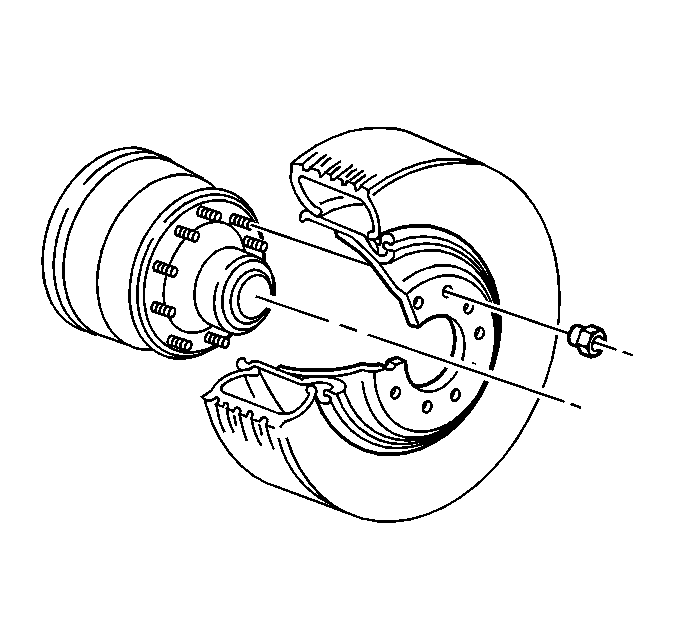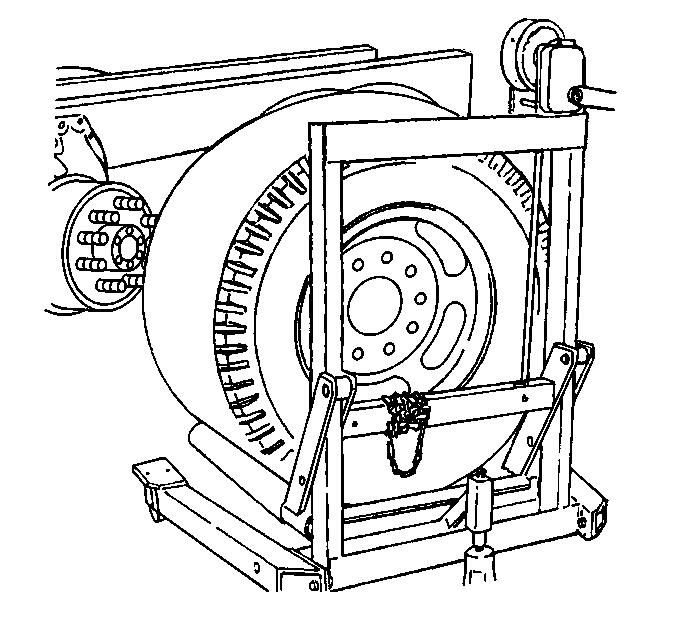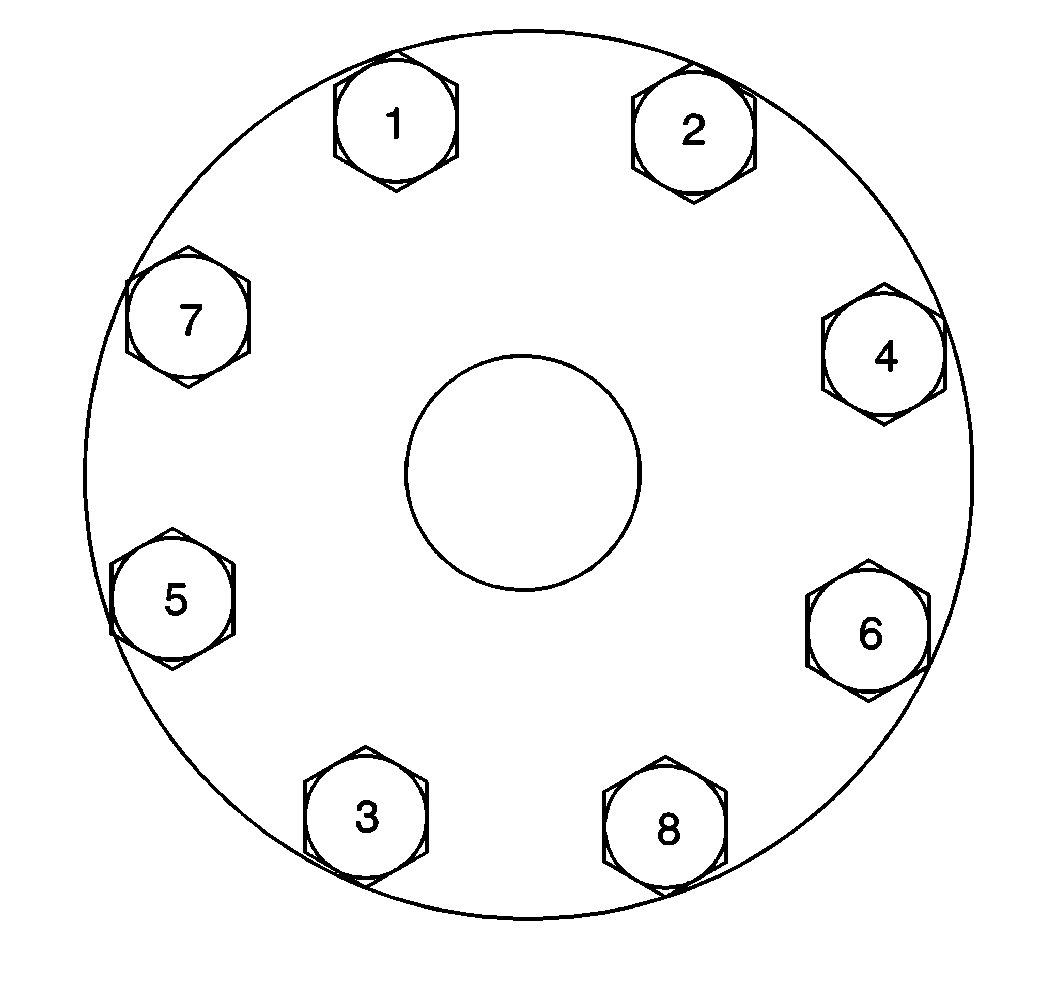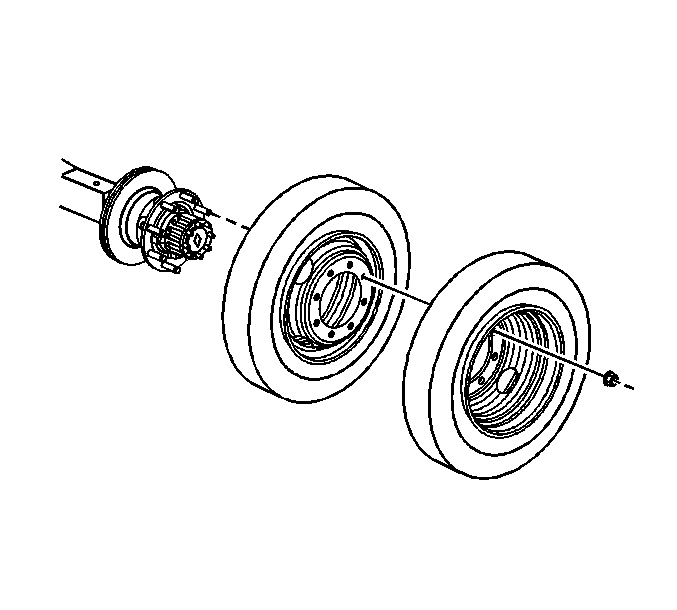Tire and Wheel Removal and Installation Drum Type - Single
Removal Procedure
- Break the wheel nuts loose.
- Block the wheels.
- Raise and support the vehicle. Refer to Lifting and Jacking the Vehicle .
- Remove the wheel nuts.
- Remove the tire and rim assembly.

Important: When removing and demounting any tire and wheel assembly, deflate the tire by removing the valve stem. Perform this procedure before removing the tire assembly from the vehicle.

Installation Procedure
- Install the wheel.
- For 8-hole wheels install the wheel nuts.
- For 10-hole wheels install the wheel nuts.
- Lower the vehicle. Refer to Lifting and Jacking the Vehicle .
- Remove the wheel blocks.

Notice: Refer to Fastener Notice in the Preface section.
Tighten
Tighten the nuts to 550 N·m (405 lb ft).
Tighten
Tighten the nuts to 644 N·m (475 lb ft).
Tire and Wheel Removal and Installation Disc Type - Single
Removal Procedure
- Break the wheel nuts loose.
- Block the wheels.
- Raise the vehicle until the tire clears the floor. Support the vehicle. Refer to Lifting and Jacking the Vehicle .
- Remove the wheel nuts.
- Remove the wheel from the hub.
Important: When removing and demounting any tire and wheel assembly, deflate the tire by removing the valve core. Perform this procedure before removing the tire assembly from the vehicle.
Installation Procedure
- Install the wheel on the hub.
- For 8-hole wheels, tighten the wheel nuts.
- For 10-hole wheels, install the wheel nuts.
- Lower the vehicle. Refer to Lifting and Jacking the Vehicle .
- Remove the wheel blocks.

Notice: Refer to Fastener Notice in the Preface section.

Tighten
Tighten the nuts to 550 N·m (405 lb ft).
Tighten
Tighten the wheel nut to 644 N·m (475 lb ft).
Tire and Wheel Removal and Installation Disc Type - Dual
Removal Procedure
- Break the wheel nuts loose.
- Block the front wheels.
- Raise and support the vehicle. Refer to Lifting and Jacking the Vehicle .
- Remove the wheel nuts.
- Remove the tire and rim assembly.

Important: When removing and demounting any tire and wheel assembly, deflate the tire by removing the valve core. Perform this procedure before removing the tire assembly from the vehicle.
Installation Procedure
- Install the inner wheel, if neccesary
- Install the outer wheel.
- For 8 -hole wheels, install the wheel nuts.
- For 10-hole wheels, install the wheel nuts.
- Lower Vehicle. Refer to Lifting and Jacking the Vehicle .
- Remove the wheel blocks.

Notice: Use the correct fastener in the correct location. Replacement fasteners must be the correct part number for that application. Fasteners requiring replacement or fasteners requiring the use of thread locking compound or sealant are identified in the service procedure. Do not use paints, lubricants, or corrosion inhibitors on fasteners or fastener joint surfaces unless specified. These coatings affect fastener torque and joint clamping force and may damage the fastener. Use the correct tightening sequence and specifications when installing fasteners in order to avoid damage to parts and systems.
Tighten
Tighten the stud nuts to 550 N·m (405 lb ft) in the sequence shown.
Tighten
Tighten the stud nuts to 644 N·m (475 lb ft).
Tire and Wheel Removal and Installation Drum Type - Dual
Removal Procedure
- Break the wheel nuts loose.
- Block the wheels.
- Raise and support the vehicle. Refer to Lifting and Jacking the Vehicle .
- Remove the wheel nuts.
- Remove the wheel from the hub.
Important: When removing and demounting any tire and wheel assembly, deflate the tire by removing the valve stem. preform this procedure before removing the tire assembly from the vehicle.


Installation Procedure
- Install the wheel to the hub.
- For the 8-hole wheels, install the wheel nuts.
- For the 10-hole wheels, install the wheel nuts.
- Lower the vehicle. Refer to Lifting and Jacking the Vehicle .
- Remove the wheel blocks.

Notice: Refer to Fastener Notice in the Preface section.
Tighten
Tighten the wheel nuts to 550 N·m (405 lb ft).
Tighten
Tighten the wheel nuts to 644 N·m (475 lb ft).
